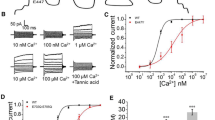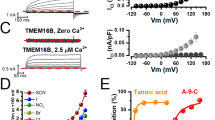Abstract
The gating of Ca2+-activated Cl− channels is controlled by a complex interplay among [Ca2+]i, membrane potential and permeant anions. Besides Ca2+, Ba2+ also can activate both TMEM16A and TMEM16B. This study reports the effects of several divalent cations as regulators of TMEM16A channels stably expressed in HEK293T cells. Among the divalent cations that activate TMEM16A, Ca2+ is most effective, followed by Sr2+ and Ni2+, which have similar affinity, while Mg2+ is ineffective. Zn2+ does not activate TMEM16A but inhibits the Ca2+-activated chloride currents. Maximally effective concentrations of Sr2+ and Ni2+ occluded activation of the TMEM16A current by Ca2+, which suggests that Ca2+, Sr2+ and Ni2+ all regulate the channel by the same mechanism.







Similar content being viewed by others
Abbreviations
- CaCCs:
-
Ca2+-activated Cl− currents
- [Ca2+]i :
-
Intracellular calcium concentration
- Vm :
-
Membrane potential
References
Andersson DA, Gentry C, Moss S, Bevan S (2009) Clioquinol and pyrithione activate TRPA1 by increasing intracellular Zn2+. Proc Natl Acad Sci USA 106(20):8374–8379
Bader CR, Bertrand D, Schwartz EA (1982) Voltage-activated and calcium-activated currents studied in solitary rod inner segments from the salamander retina. J Physiol 331:253
Barish ME (1983) A transient calcium-dependent chloride current in the immature Xenopus oocyte. J Physiol 342:309–325
Caputo A, Caci ELF, Pedemonte N, Barsanti C, Sondo E et al (2008) TMEM16A, a membrane protein associated with calcium-dependent chloride channel activity. Science 322(5901):590–594
Cenedese V, Betto G, Celsi F, Cherian OL, Pifferi S, Menini A (2012) The voltage dependence of the TMEM16B/anoctamin2 calcium-activated chloride channel is modified by mutations in the first putative intracellular loop. J Gen Physiol 139(4):285–294
Chao SH, Suzuki Y, Zysk JR, Cheung WY (1984) Activation of calmodulin by various metal cations as a function of ionic radius. Mol Pharmacol 26(1):75–82
Chen Y, An H, Li T, Liu Y, Gao C, Guo P, Zhan Y (2010) Direct or indirect regulation of calcium-activated chloride channel by calcium. J Membr Biol 240(3):121–129
Falke JJ, Drake SK, Hazard AL, Peerson OB (1994) Molecular tuning of ion binding to calcium signaling proteins. Q Rev Biophys 27(3):219–290
Ferrera L, Caputo A, Ubby I, Bussani E, Zegarra-Moran O, Ravazzolo R et al (2009) Regulation of TMEM16A chloride channel properties by alternative splicing. J Biol Chem 284(48):33360–33368
Hartzell C, Putzier I, Arreola J (2005) Calcium-activated chloride channels. Annu Rev Physiol 67:719–758
Hou S, Vigeland LE, Zhang G, Xu R, Li M, Heinemann SH, Hoshi T (2010) Zn2+ activates large conductance Ca2+-activated K+ channel via an intracellular domain. J Biol Chem 285(9):6434–6442
Huang F, Rock JR, Harfe BD, Cheng T, Huang X, Jan YN, Jan LY (2009) Studies on expression and function of the TMEM16A calcium-activated chloride channel. Proc Natl Acad Sci USA 106(50):21413–21418
Huang F, Wong X, Jan LY (2012) International Union of Basic and Clinical Pharmacology. LXXXV: calcium-activated chloride channels. Pharmacol Rev 64(1):1–15
Jia Q, Jia Z, Zhao Z, Liu B, Liang H, Zhang H (2007) Activation of epidermal growth factor receptor inhibits KCNQ2/3 current through two distinct pathways: membrane PtdIns(4,5)P2 hydrolysis and channel phosphorylation. J Neurosci 27(10):2503–2512
Jung J, Nam JH, Park HW, Oh U, Yoon JH, Lee MG (2013) Dynamic modulation of ANO1/TMEM16A HCO3 − permeability by Ca2+/calmodulin. Proc Natl Acad Sci USA 110(1):360–365
Kanjhan R, Bellingham MC (2011) Penetratin peptide potentiates endogenous calcium-activated chloride currents in Xenopus oocytes. J Membr Biol 241(1):21–29
MacLeish PR, Nurse CA (2007) Ion channel compartments in photoreceptors: evidence from salamander rods with intact and ablated terminals. J Neurophysiol 98(1):86–95
Miledi R (1982) A calcium-dependent transient outward current in Xenopus laevis oocytes. Proc R Soc Lond B 215(1201):491–497
Namkung W, Thiagarajah JR, Phuan PW, Verkman AS (2010) Inhibition of Ca2+-activated Cl− channels by gallotannins as a possible molecular basis for health benefits of red wine and green tea. FASEB J 24(11):4178–4186
Prost AL, Bloc A, Hussy N, Derand R, Vivaudou M (2004) Zinc is both an intracellular and extracellular regulator of KATP channel function. J Physiol 559(Pt 1):157–167
Schroeder BC, Cheng T, Jan YN, Jan LY (2008) Expression cloning of TMEM16A as a calcium-activated chloride channel subunit. Cell 134(6):1019–1029
Scudieri P, Sondo E, Caci E, Ravazzolo R, Galietta LJ (2013) TMEM16A–TMEM16B chimaeras to investigate the structure–function relationship of calcium-activated chloride channels. Biochem J 452(3):443–455
Stephan AB, Shum EY, Hirsh S, Cygnar KD, Reisert J, Zhao HQ (2009) ANO2 is the cilial calcium-activated chloride channel that may mediate olfactory amplification. Proc Natl Acad Sci USA 106(28):11776–11781
Xiao QH, Yu K, Perez-Cornejo P, Cui YY, Arreola J, Hartzell HC (2011) Voltage- and calcium-dependent gating of TMEM16A/Ano1 chloride channels are physically coupled by the first intracellular loop. Proc Natl Acad Sci USA 108(21):8891–8896
Yang H, Kim A, David T, Palmer D, Jin T, Tien J et al (2012) TMEM16F forms a Ca2+-activated cation channel required for lipid scrambling in platelets during blood coagulation. Cell 151(1):111–122
Young DY, Cho HW, Koo JY, Tak MH, Cho YY, Shim WS et al (2008) TMEM16A confers receptor-activated calcium-dependent chloride conductance. Nature 455(7217):1210–1236
Yu K, Duran C, Qu Z, Cui YY, Hartzell HC (2012) Explaining calcium-dependent gating of anoctamin-1 chloride channels requires a revised topology. Circ Res 110(7):990–999
Zeng XH, Xia XM, Lingle CJ (2005) Divalent cation sensitivity of BK channel activation supports the existence of three distinct binding sites. J Gen Physiol 125(3):273–286
Acknowledgments
This work was supported by 11247010 from NSFC and C2012202079 from Hebei NSFC to H. A., 11175055 from NSFC to Y. Z., 31270882 from NSFC and 2013CB531302 from National Basic Research Program to H. Z., and 30900267 from NSFC to Z. Z.
Author information
Authors and Affiliations
Corresponding authors
Electronic supplementary material
Below is the link to the electronic supplementary material.
Rights and permissions
About this article
Cite this article
Yuan, H., Gao, C., Chen, Y. et al. Divalent Cations Modulate TMEM16A Calcium-Activated Chloride Channels by a Common Mechanism. J Membrane Biol 246, 893–902 (2013). https://doi.org/10.1007/s00232-013-9589-9
Received:
Accepted:
Published:
Issue Date:
DOI: https://doi.org/10.1007/s00232-013-9589-9




